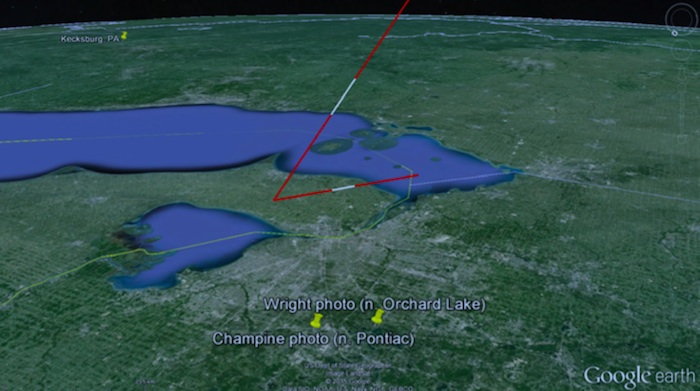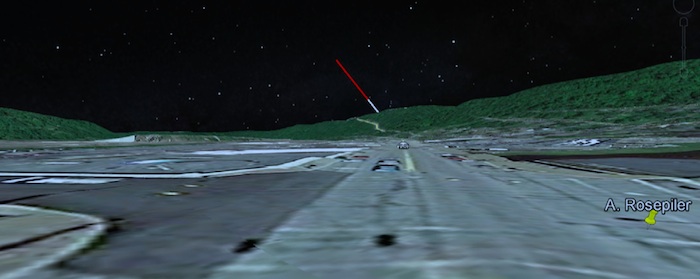.
Kecksburg update
The recent effort to explain the Kecksburg case rekindled interest in the subject. My opinion about the Mk2 re-entry vehicle ex- planation was that it was a wasted effort. There is a perfectly good explanation that has existed since 1965. The fireball, which had been seen in Ohio, Michigan, Ontario, and Pennsylvania, had fooled the local population into thinking that something fell into the woods that evening. Nothing was ever found and there are no records to suggest otherwise. The rest of the story that Stan Gordon has been peddling is nothing more than a myth. The only “facts” that support this myth are the decades old testimonies of individuals, who have suspect motives.
Ted Molczan debunking
Ted Molczan pretty much debunked the new explanation with a lot of useful information. There is no reason to recount his rebut-
1 tal here since it is already public knowledge at Vicente-Juan Ballester Olmos’ blog .
Ted also chose to look at the fireball explanation as well as arguments against it. Using Google Earth, he created 2D and 3D trajec- tories based on the Krause/Chamberlain calculations. His results were reasonably close to what appeared in the photographs.
Mr. Molczan decided to start the meteor’s visible path at a height of 60 km (the normal altitude for slow meteors), which is where the red line begins. The white segment is the altitudes for the begin and end point of the debris trail. The subsequent red segment after this is the path any surviving meteorites might have taken to the earth. Ted has since informed me that atmospheric drag would have resulted in a more vertical fall of any surviving meteorites. For the purpose of this article, I am using his diagrams that do not incorporate that drag for the post train line segment. This diagram shows the 3D trajectory and the 2D ground track:
.

Ted notes that there are some minor variations in regards to the slope of the path between the photographs and the Google Earth files. He thinks it probably had to do the cameras not being perfectly level with the horizon but it might be due to some distortion introduced by Google Earth. Molczan commented that he felt the variations were not that significant. The Pontiac track is on the left and the Orchard Park track is on the right:
.

Mr. Molczan also commented about the possibility that an error was made by Krause and Chamberlain in the path computation:
I find it difficult to imagine any likely error in the analysis of the smoke trail photos, that if corrected, would result in impact near Kecks- burg. It is important to bear in mind that not only the azimuths must intersect, but the elevations of A and B also constrain the solution2.
Ted then pointed me towards an article that appeared in the Beaver County Times on December 10, 1965. It describes the observa- tions of one witness, Andrew Rosepiler, who gave a reasonable precise location for his vehicle. From that position, he gave a fairly accurate description of the meteor’s trajectory:
Rosepiler was westbound on Midland Avenue at Seventh Street, when he saw the “fireball” fall at a “very steep and slightly arched” angle. HE JUDGED the object about the size of a football with a 10 to 25 foot flaming tail streaking behind it. He said it appeared that it would hit a hillside just outside Midland behind the Petrosol Service Station along Route 68 (scientists say this is a common illusion when observing flying objects). Rosepiler said he watched the object because he thought it would explode when it hit. He thinks it hit about two thirds the way up the hill. He said he drove to higher ground for a better view of the hill side, expecting a fire to have started, but said he saw no fire or smoke.3
When Molczan used Rosepiler’s position and his Google Earth trajectory, he got the following result:
.

This is a good reproduction of his observation. It also indicates that the meteor did not pass over his position towards Kecksburg.
There are a few other 1965 reports that can be found in the news media, where the witnesses gave locations and directions of ob- servation. I found an article in the Massillon, Ohio newspaper, where several reports were listed. The most precise location came from a driver at an intersection:
Paul McCormick...was waiting for the green light at Amherst rd and Lake ave. NE when he saw the ball of fire in the sky trailing smoke. He said it was so plain, you might have thought it was falling near Traphagen Rd NW.4
Ted put this location into his model and got this view:
.

Ted’s fireball track mirrors the actual scientific evaluation of the meteor’s track back in 1965-66 by Chamberlain, Krause and Douglas (of the Canadian National Research Council Associate Committee on Meteorites) . Dr. Douglas stated in his report:
On-the-spot interviews of some seventy observers (now close to 100) were made by Mr. Henry Lee, President of the Windsor Centre of the RASC, and the writer during part of January. Reduction of this sighting data confirmed the general ground position of the end-point as was determined from the photographs by Mr. Chamberlain. Contacts with eyewitnesses were obtained through requests in a daily and four weekly newspapers, radio station CJSP, Leamington, and through area high schools.5
As I stated in SUNlite 3-6, the data gathering in 1965-66 confirmed the trajectory of the fireball. I have yet to see anybody demon- strate that these calculations were incorrect or provide accurate descriptions from 1965 that indicates a different track. Therefore, there is no reason to revise it based on the claims made decades later by people interested in perpetuating their participation in the Kecksburg myth.
The Kalp observations
After pointing Ted towards SUNlite 3-6, he chose to plot the appearance of the fireball and resulting debris trail as viewed by the Kalp children that evening. Using the positions of the children provided by Bob Young and the computed trajectory from the photographs, Ted provided us with the view the children had looking at the fireball. As can be seen in Ted’s recreation, one can un- derstand why they thought something had landed in the woods. The debris trail hovering over the trees made it appear that there was smoke emanating from the woods. The conclusion drawn by Mrs. Kalp was that the object had apparently fallen into the woods and she called the authorities. What transpired next is history.
.

The fireball explanation still stands
Hopefully, this information will supplement what I already published in SUNlite 3-6. Mr. Molczan’s work, which I greatly appre- ciate, confirms the fireball explanation for Kecksburg. While the proponents of the case can make all the claims they want, the actual science done in 1965 indicates it was a case of a misperceived fireball that evolved into a myth.
Quelle: SUNlite 1/2016
4081 Views
